In this article, you will learn what are the different types of nails? When and how to use them? explained with Pictures.
You can also download the PDF file of this article at the end of it.
What is a Nail?
A nail is a small part made of metal used as a fastener, as a peg for hanging something, or sometimes as a decoration. As everyone knows, nail application is commonly found in woodworking and construction.
Typically, nails have a pointed tip at one end and a flattened head at the other, but they are also available without a head. Nails are generally driven into the workpiece using a hammer or pneumatic nail gun.
The primary function of the nail is to hold the material together in an axial direction by friction and subsequent shearing force. Sometimes the tip of the nail is also bent or clamped after driving to prevent it from coming out.
Nails are manufactured in a wide variety of forms for particular purposes. The variation in nail shape and design makes it suitable for specific uses. This guide describes the types of nails to help you find the best nails for your projects.
Read Also: What are different types of Measuring Tools? [PDF]
Parts and Design of a Nail
Nails have four common parts which are listed below,
- Nail point
- Head
- Shank
- Nail coating
#1 Nail Point
The nail points are diamond-shaped, which is valid for general use and makes it easy to drive the nails. Some nails have blunt points that make them harder to drive but less likely to split the workpiece.
#2 Head
The top of the nail is called the head, it is designed to accept the pointed end of the nail, making it easy to counter the nail without slipping and digging into the wood.
Nails are created with different types of heads and each has its characteristics. Some nail heads are round heads, counter sunk heads, flat heads, checkered heads, clipped heads, etc.
#3 Shank
The nail shank is the part that does most of the holding. The nail shanks keep the nails in position even under extreme pressure. This shank is tied in place between the fibers of the wood, and the fibers are pressed against the shank.
It is because of this pressure that it is so difficult to remove the nail from the wood. Nails are generally made with several types of nails, such as smooth-shank, spiral-shank, ring-shank nails, or annular nails.
#4 Nail Coating
The nails are not coated, but some are treated with a material to lubricate the shank, improving driving efficiency or holding power. A process called galvanization is done when manufacturing the nail, which covers the nails with zinc to provide some protection against corrosion.
Read Also: Types of Clamps & Their Uses [How To Use Guide]
Types of Nails
The following are the main types of nails:
# 1 Common Nails
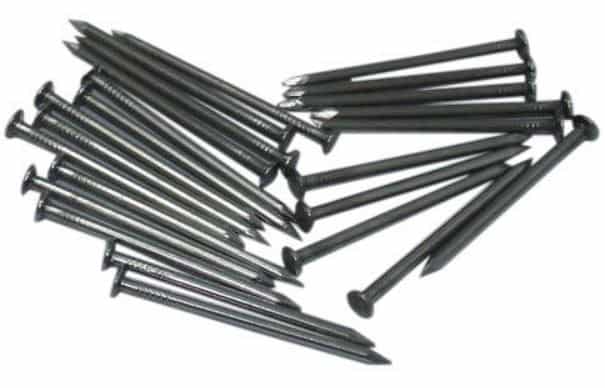
Common nails are used for general construction, framing, and other structural work. This usually has a thick leg, broad head, and diamond-shaped point. They are best for fastening jobs where nail strength matters more than appearance.
The rounded head of a regular nail is usually visible, making this nail style better for work where function is more important than appearance. These heavy-duty nails are best used for rough work projects in terms of strength.
#2 Framing Nails
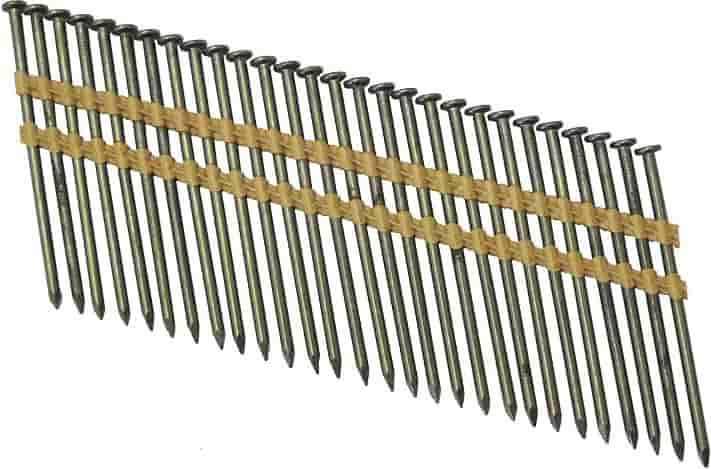
Framing nails are generally used in heavy-duty construction and are usually gun-fired to attach wood to wood. Apart from this, these types of nails are also used for crafting projects and craft projects.
These nails are strong and durable with a pointed end that is designed to drive motion through the material without splitting. It is generally longer and ideal for framing buildings or other woodworking projects requiring a solid structure. Some framing nails are slightly thinner, making them easier to drive and keep flush or even sink in for aesthetic reasons.
#3 Box Nails
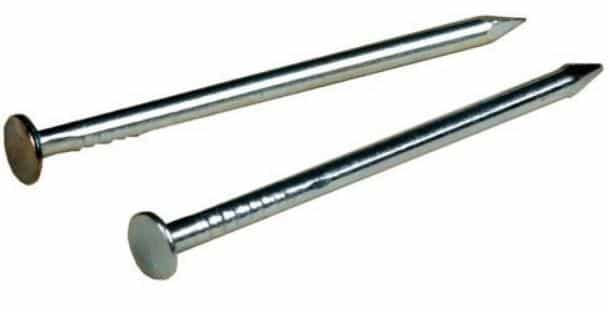
A box nail is similar to a regular nail but has a thinner shank and is used on lighter pieces of wood and boxes. This smaller diameter of the shank reduces the chance of splitting the wood components when you drive the nail.
These nails are also often galvanized to prevent corrosion. Most often, these types of nails are seen in lightweight construction because they are thinner and have less strength than normal nails. Since box nails have low strength, they are not suitable for structural applications.
#4 Deck Nails
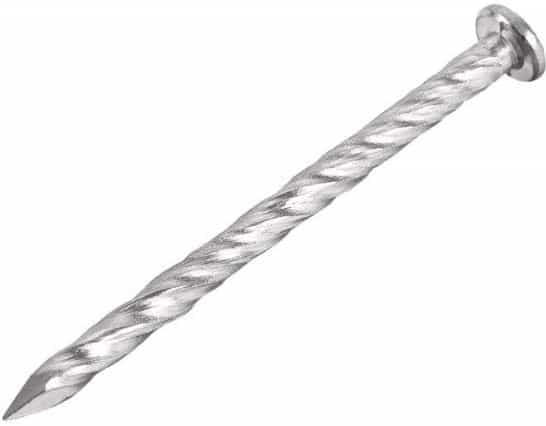
When selecting nails for decking, stainless steel deck nails are the best choice because they offer more resistance to corrosion with minimal discoloration for wood such as cedar. These often have a checkered head for better contact with the hammer.
They usually have smaller diameter shafts to reduce splitting. The shanks often feature rings or a spiral flute that helps ensure that the nails remain in place despite the drying and weathering conditions exposed to the deck. Deck nails are used outdoors and with treated lumber.
#5 Sinker Nails
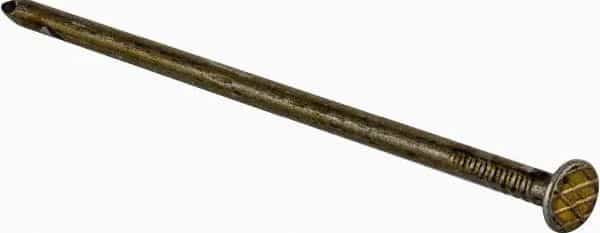
Sinker nails are thinner than common nails, have flat heads, and are often coated, so the nails can quickly drive them flush or even counter-sunk. Because they have a checkered head that helps prevent the hammer from slipping through the nailhead.
They are usually coated in either cement or vinyl, which provides lubrication while driving and increases the holding power. Once the nail is set, the rings on the top help to hold it in place while the vinyl cools and solidifies, forming an adhesive bond. These are used for framing and general construction applications.
Read Also: What is a Drill Bit? Its Types and Using Guide [PDF]
#6 Masonry Nails
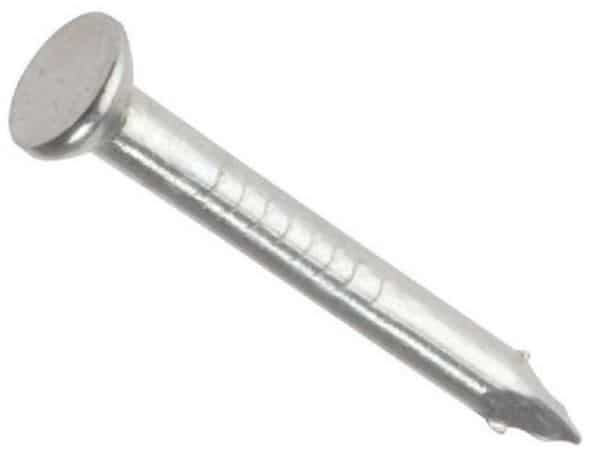
Masonry nails are solid and hard nails used to fasten objects to walls, ceilings, and other surfaces. These are typically made of tough materials such as steel, which allows them to be carried across masonry surfaces such as concrete and brick.
The grooved shaft of the nail attaches to the surface, preventing the nail from loosening. Extruded masonry nails are short and thick, with rounded, curved, or oval shanks. These nails are suitable for medium-duty applications when anchoring is not the preferred option.
#7 Roofing Nails
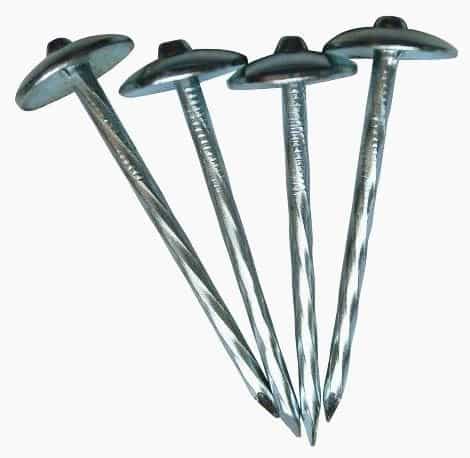
A roofing nail is a small nail with a large flat head and a barbed shank that is used to secure roofing paper or asphalt shingles to a roofing board. They are considered best for securing asphalt shingles, roof felt, and roof decking or sheathing.
They can be made of aluminum or have a finish that protects against corrosion. Some types have a gasket under the head to create a weather-resistant seal. Sometimes, these types of nails are also slightly bent to increase the holding power.
#8 Spiral Shank Nails
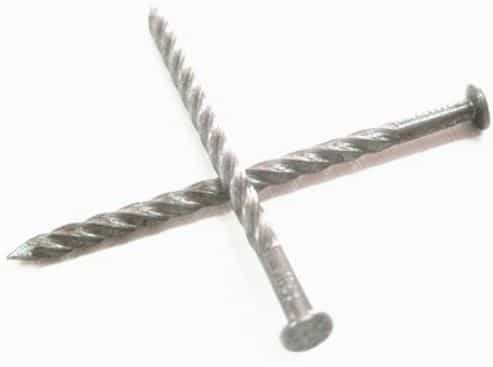
Usually, the shanks of a spiral shank nail look more like a screw. A spiral thread on the shank causes the nail to rotate during installation, creating a thread-like interlock with the wood, which increases clearance.
They twist and form their threads as they are nailed into the wood. These are designed to drive smoothly across hardwoods and dense materials while providing increased resistance. Spiral shank nails are primarily used in flooring, siding, decking, pallets, and truss rafters.
#9 Joist Hanger Nails
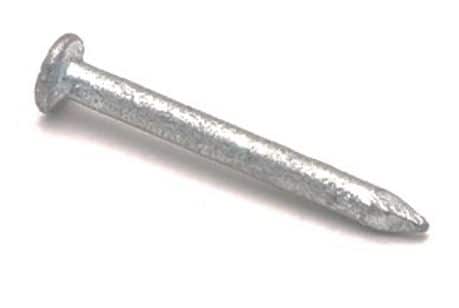
To secure the hangers to the joists, the user only needs to use galvanized joist hanger nails 1-1/2 inches long. Joist hanger nails are typically shorter and heavier gauge nails that provide increased holding power without completely penetrating the wood.
These nails have a strong shank to provide strength and are often hot-dip galvanized for outdoor use and for use with treated wood.
#10 Duplex Nails
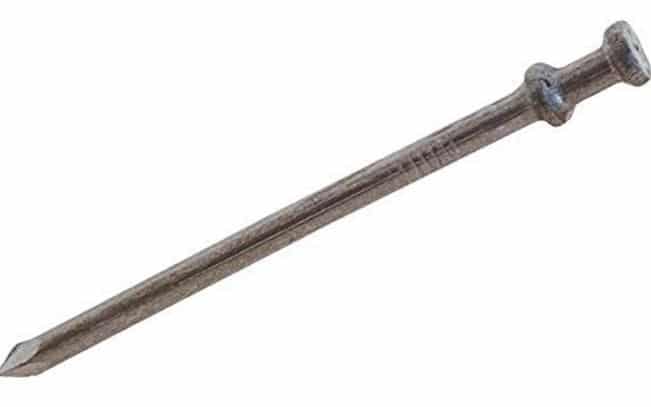
Before the creation of duplex nails, common nails were widely used in formwork applications. Duplex nail flange or double-ended fasteners are often used for building temporary structures such as braces, scaffolding, and concrete formwork.
These are used for temporary purposes, designed to be easily removed so they don’t go completely into the wood during installation. They have two heads along the shank, one that secures the nail against the work, and another allows easy removal.
Checkout: What are the different types of Punches? How to use them?
#11 Pole Barn Nails
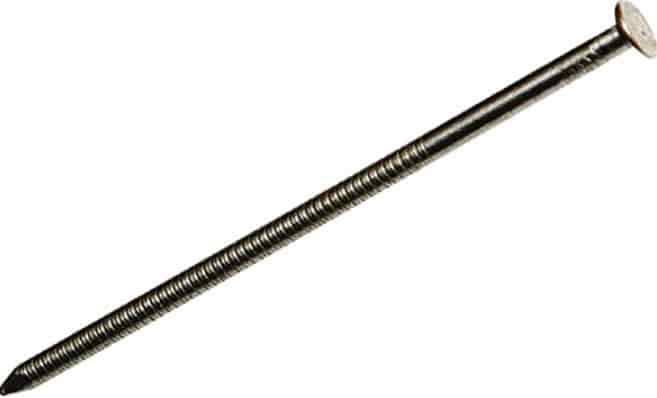
Pole barn keel is used in load-bearing wooden structures where superior holding strength is required. Also, these are chosen for construction projects that use wooden poles installed in the ground to form the structure’s foundation.
Pole barn nails are typically made of high carbon steel for greater hardness. These types of nails have ring shanks for holding power and a rust-resistant finish that is well suited to pressure-treated lumber.
#12 Connector Nails
Connector nails are designed to connect structural hardware such as framing angles and raft ties. Connector nails are usually available with a conical shape on the bottom of the head. These are recommended for structural assemblages and wood installations to achieve a published load-carrying capacity.
#13 Cap Nails
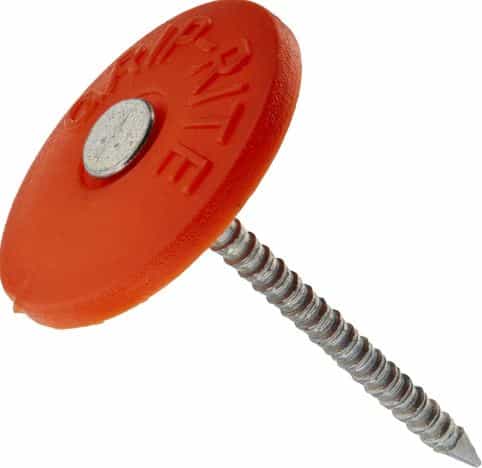
The cap nails are used for attaching roofing felt, house wrap, tar paper, and insulation foam board. Unlike common nails, a cap nail has a steel shank and a large polyethylene cap to avoid leaks.
These types of nails have a spiral shank that holds the fastener in place. These nails have a plastic cap just below the nail head that secures wrap, felt, or foam insulation and prevents tearing.
#14 Trim Nails
Trim nails are designed to be used for exterior purposes on homes. These nails secure home gutters, fascia, and soffit boards as well as exterior trim.
#15 Finishing Nails
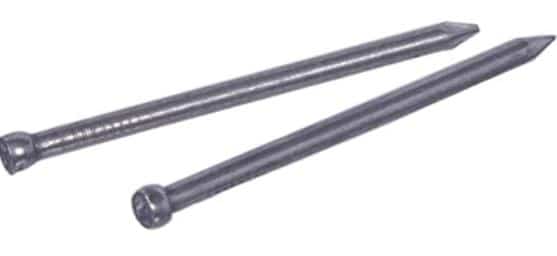
Finishing nails are generally made of steel wire, making them slightly thicker in diameter than brad nails. These nails are used for finishing whose small cylindrical head is easily reversed, and a filler covers the resulting hole.
In addition, they are also used in carpentry and cabinetry and work well for molding. The smaller diameter shank minimizes the chances of splitting the workpiece. These nails are lighter than standard nails and have a smaller head. It usually ranges from 16 to 10-gauge and is very strong.
Read Also: Types of Saws Used in Workshop (Functions Explained)
#16 Brad Nails
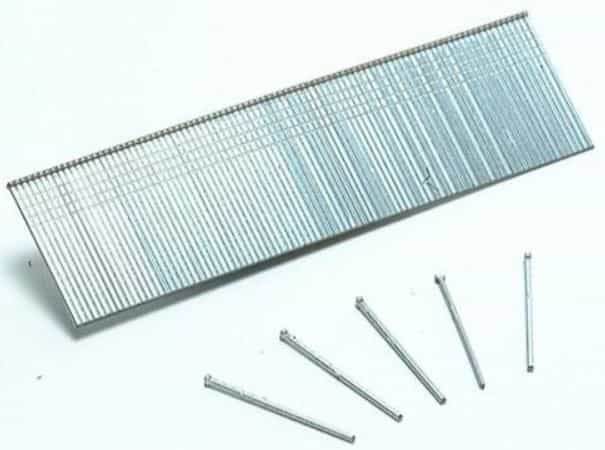
Brad nails are made of 18-gauge steel wire that is usually thick in size. Braid nails are more subtle than standard nails, making them an excellent choice for projects that require a neat look.
These are smaller in size and have less holding power, but they are suitable for woodworking, cabinetry, and craft work. Like finish nails, brad nails have their heads only slightly larger than the diameter of the shaft to allow for counter sinking. In addition to being thinner nails, they also have smaller heads.
#17 Pin Nails
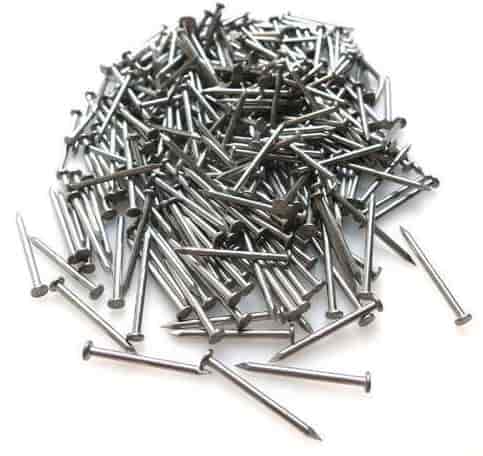
Pin nails are sometimes called thin nails because they have very little lasting holding power. The pin nails are used to temporarily hold something in place. These are very small in diameter (23 gauge) and are usually available without a head.
Although they don’t have a lot of holding power, they are imperceptible and can be attached with thin veneers and glue to secure small pieces of molding and trim. Pin nails are interchangeable between nail guns and are widely available.
#18 Drywall Nails
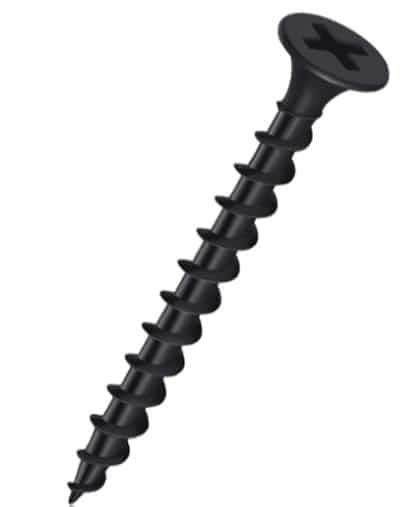
Drywall nails have a ring or barbed shank that provides greater holding power. These features allow them to operate easily beneath the surface of the wallboard to conceal them and reduce the tearing of drywall paper.
These are also made of long diamond-shaped points designed to reduce the splitting of wall studs. The main purpose of using these nails is to attach gypsum board and drywall. Often people choose to use drywall screws, which are similar to drywall nails.
#19 Panel Board Nails
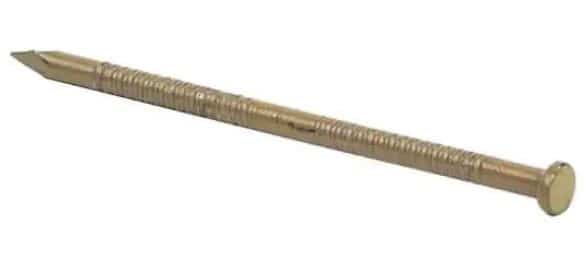
Panel board nails are typically manufactured with a small, rounded head and are used for fastening wall panels to wood furring or studs. But some panel nails have ring shanks to hold power and are often painted in different colors to match the installing panel.
#20 Flooring Nails
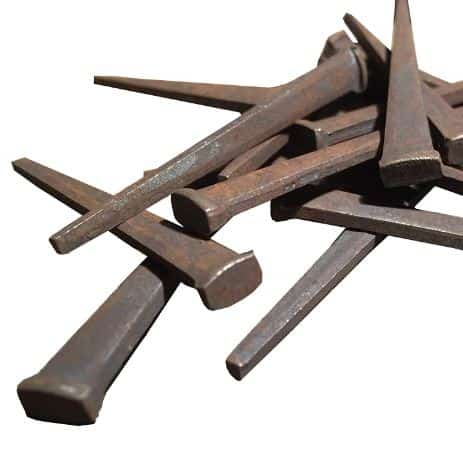
Flooring nails are available in a variety of designs depending on the material of the flooring to which it is intended to be attached. Some common flooring nails have rings similar to screws for attaching to plywood or another subfloor.
These rings help reduce slippage and ensure that any material is attached very securely. They are designed for use in pneumatic nailers to install certain types of wood floors. As well as the short spiral nails that secure floor trim and nails with longer ring shanks for installing subflooring.
Don’t Miss Out: 10 Different Types of Thread Taps & Their Uses
#21 Furniture Nails
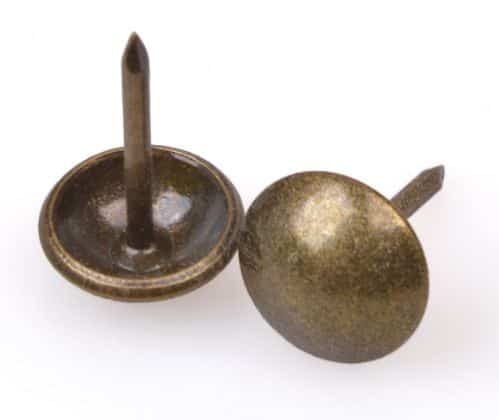
Also called upholstery nails, they are used to fasten materials to furniture or directly to leather sofas for trim. Furniture nails can be easily hammered 2.5 cm into the front and back of the seat of the chair.
The primary function of the furniture nails is to secure the upholstery fabric to the wooden frame. These types of nails are usually short in length with relatively large, decorative heads.
#22 Annular Ring Nails
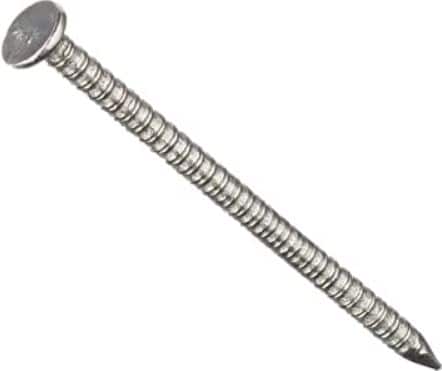
Annular ring nails have rings on the shank that provide better grip and added resistance when used in wood. These nails are made of carbon steel and do not have a rust-resistant coating and will therefore rust in moist conditions.
These are used to install subflooring, where the extra holding power can help keep the floor from creaking. The threads on the nail give excellent holding power in concrete block and masonry applications. In addition, they are also used in plywood, underlayment, decking, siding, and roofing applications.
#23 Miscellaneous Nails
Miscellaneous nails are less common nails used by both laypeople and professional construction workers.
These nails are coated with cement and resin for added holding power, and drywall nails are mainly used for hanging wallboards. Actually, Any type of nail that doesn’t fit the regular category or is used unusually can fit into this type of nail.
#24 Tacks
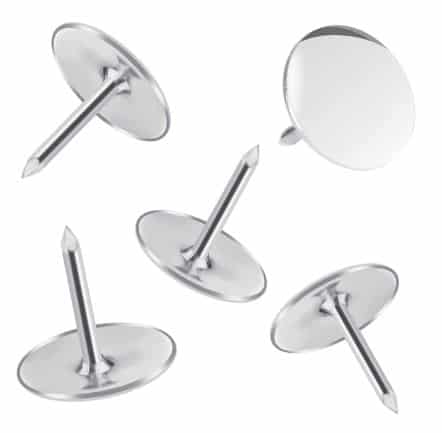
Tacks are small nails with a broad, flat head, that are used to fix carpets to floors and to pull clothes on wood. In addition, they are often used to repair floorboards, fix rugs, and pull the fabric on a piece of wood.
#25 Hardboard Nails
Thanks to a diamond-shaped head, hardboard nails are designed to be barely seen once fully hammered into the hardboard. These nails are found in sizes ranging from three-eighths to one and a half inches.
Read Also: What are the Types of Rivets and Riveted Joints? Their Applications
Sizes of Nails
Most nail lengths of all types can be indicated by the inch or penny system, shortened with D (16D nails). Initially, the penny system indicates the length of the nail. A higher number means a longer length. Some of the nail sizes are listed below:
| Penny Type | Length (inch) |
|---|---|
| 2D | 1 in |
| 3D | 1 – 1/4 in |
| 4D | 1 – 1/2 in |
| 5D | 1 – 3/4 in |
| 6D | 2 in |
| 8D | 2 – 1/2 in |
| 10D | 3 in |
| 12D | 3 – 1/4 in |
| 16D | 3 – 1/2 in |
| 20D | 4 in |
| 30D | 4 – 1/2 in |
| 40D | 5 in |
| 60D | 6 in |
Tips for Using Nails
When employing nails, keep these tips in mind:
- It is easier to drive nails into harder wood or into the end of a piece of wood if you drill a pilot hole first.
- The nail needs to be turned upside down and tapped several times with a hammer in order to blunt the tip. While blunt nails are more difficult to drive, splitting wood is less likely to occur.
- Nails hammered through or up against the grain of the wood secure the nail position. Driving nails against the grain will make them come out easier.
- Use aluminum nails, which resist rust even better than rust-resistant coatings, if you’re worried about rust harming your nails. They are most commonly found on metal siding or screens.
- Stainless steel nails are required for hammering into cedar or redwood since they are non-corrosive and non-degradable. Additionally, they won’t leave stains or streaks on your wood.
- Keep in mind that driving many nails along the same grain line increases the likelihood of splitting wood.
- When driving a nail into masonry, wear safety goggles at all times.
Conclusion
As I said already, A nail is a type of fastener used to fasten one or more objects to each other. These are designed for building potentially large and permanent structures. Hope you understand that there are many types of nails and each has its own uses.
So now, I expect I’ve covered everything about “types of nails“. If you still have any doubts or questions on this topic, you can contact us or ask in the comments. If you like this article then please share it with your friends.
Want free PDFs direct to your inbox? Then subscribe to our newsletter.
Download PDF of this article:
You might like to read more about workshop tools in our blog:
i found a 12″ long nail that has a 5/16″ diameter shank. it has 22 stamped in the head which is 3/4″ diameter by 3/16″ thick. what is it, i found it inside the refinery where i work. it wasn’t to far from a railroad track but it isn’t a traditional RR spike.
It’s difficult to identify without more information. It could be a specialized nail used for industrial purposes.
Great Piece of Information. Thanks dear
You’re most welcome.